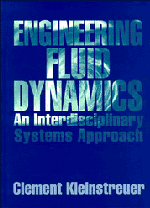Book contents
- Frontmatter
- Contents
- Preface
- List of Symbols and Abbreviations
- Chapter 1 Preliminary Concepts
- Chapter 2 Derivations and Transformations of the Conservation Equations
- Chapter 3 Analyses of Basic Fluid Flow Problems
- Chapter 4 Nonisothermal Flows
- Chapter 5 Selected Case Studies
- Appendix A Differential Operators and Cartesian Tensor Applications
- Appendix B Basic Equations in Rectangular, Cylindrical and Spherical Coordinates
- Appendix C Simplified Governing Equations
- Appendix D Stream Function Formulation in Planar and Axisymmetric Coordinates
- Appendix E Physical Properties of Gases and Liquids
- Appendix F Numerical Tools and Program Listings
- Index
Chapter 1 - Preliminary Concepts
Published online by Cambridge University Press: 05 June 2012
- Frontmatter
- Contents
- Preface
- List of Symbols and Abbreviations
- Chapter 1 Preliminary Concepts
- Chapter 2 Derivations and Transformations of the Conservation Equations
- Chapter 3 Analyses of Basic Fluid Flow Problems
- Chapter 4 Nonisothermal Flows
- Chapter 5 Selected Case Studies
- Appendix A Differential Operators and Cartesian Tensor Applications
- Appendix B Basic Equations in Rectangular, Cylindrical and Spherical Coordinates
- Appendix C Simplified Governing Equations
- Appendix D Stream Function Formulation in Planar and Axisymmetric Coordinates
- Appendix E Physical Properties of Gases and Liquids
- Appendix F Numerical Tools and Program Listings
- Index
Summary
Introduction and Overview
As indicated in the Preface, the main objectives of this book are to provide the reader, in a unifying way, with classical material in fluid mechanics and convection heat transfer and to introduce him or her to basic techniques for modeling engineering fluid dynamics systems. Thus, studying the book in a formal graduate course setting may enhance the student's physical understanding, increase problem-solving skills, and build up confidence to solve other thermal flow problems not discussed in this text. The approach and objectives of problem-solving steps, or in more complex cases “model development” in the engineering sciences, are summarized in Fig. 1.1. This sequence will be highlighted throughout.
The material in Chapters 1 and 2 together with Appendices A and B may equalize readers' different entry levels in fluid dynamics, systems analysis, and engineering mathematics. Specifically, in Section 1.2.1, the two fundamental flow field descriptions (i.e., Lagrange vs. Euler) are reviewed; Sections 1.2.2–1.2.4 discuss the kinematics of shear flow (i.e., fluid element translation, rotation, and deformation), thermodynamic properties (e.g., pressure, temperature, density, and entropy), and transport properties (e.g., viscosity, conductivity, and diffusivity). Some basics of particle dynamics are extended to fluid particle dynamics in Section 1.3. Differential operators and cartesian tensor applications, useful for Sections 1.2.2 and 1.3 as well as for Chapter 2 are summarized in Appendix A. Fluid flow systems under consideration in Chapters 1–5 are restricted to single-phase flow, continuum mechanics, deterministic processes, and Eulerian flow descriptions (cf. Sect. 1.4).
- Type
- Chapter
- Information
- Engineering Fluid DynamicsAn Interdisciplinary Systems Approach, pp. 1 - 38Publisher: Cambridge University PressPrint publication year: 1997



